View in other NatureServe Network Field Guides
NatureServe
Montana
Utah
Wyoming
Idaho
Wisconsin
British Columbia
South Carolina
Yukon
California
New York
Grizzled Skipper - Pyrgus centaureae
Native Species
Global Rank:
G5
State Rank:
S5
Agency Status
USFWS:
USFS:
BLM:
External Links
General Description
[From Ferris and Brown 1981; Scott 1986; Layberry et al. 1998; Opler and Wright 1999; Glassberg 2001; Pyle 2002] Large for western checkered (Pyrgus) skippers. Forewing 1.4-1.5 cm. Fringes checkered white with black tufts at vein endings. Uppersurface dark gray-brown with squarish white checks, forewing with small bar in discal cell and missing white spot in basal (inner) spotband, hindwing with blurred white spots; undersurface of hindwing gray-brown to black checkered with whitish spots, veins whitish.
Phenology
One flight, mid-April to mid-May in the eastern US, late June to August in western US, mid-June through July in the Arctic (Scott 1986). June to early August (Glassberg 2001). Mid-May to August in Canada (Layberry et al. 1998). Late June to early August in Rocky Mountain states (Ferris and Brown 1981). Early June to late August in Washington (Pyle 2002), late June to early August in British Columbia (Threatful 1988; Guppy and Shepard 2001).
Diagnostic Characteristics
Best determined by a combination of habitat, checkered fringes, uppersurface of forewing missing a white spot in basal (inner) spotband, hindwing with blurred white spots; undersurface of hindwing gray-brown to black checkered with whitish spots, veins whitish.
Species Range
Montana Range
Range Descriptions
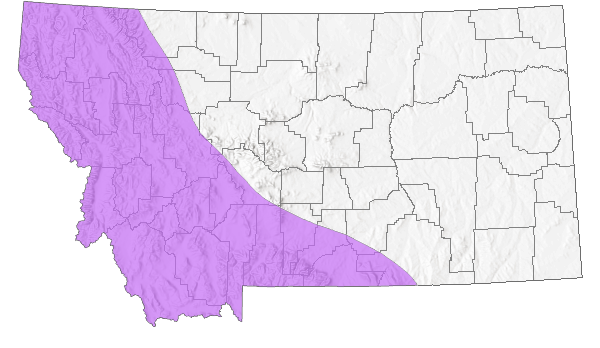
 Native
Native
Range Comments
Holarctic. In North America, Alaska south to northern Washington, in the Rocky Mountains to northern New Mexico, east across boreal Canada and northern Great Lakes region to Labrador and arctic Quebec, south in the east to the central Appalachian Mountains (Ferris and Brown 1981; Scott 1986; Opler and Wright 1999; Glassberg 2001; Guppy and Shepard 2001; Pyle 2002); 2865 m to at least 3962 m elevation in Colorado (Brown 1957; Scott and Scott 1978; Ferris and Brown 1981), 2042 m to 2316 m elevation in southeastern British Columbia (Threatful 1988). In Montana, reported from at least 13 counties in the mountainous western 1/3 of the state (Kohler 1980; Stanford and Opler 1993; FLMNH Lepidopterists' Society database), to at least 3078 m. Rare to uncommon (Glassberg 2001).
Observations in Montana Natural Heritage Program Database
Number of Observations: 1
(Click on the following maps and charts to see full sized version)
Map Help and Descriptions
Relative Density
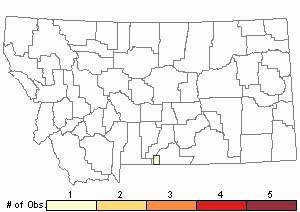
Recency
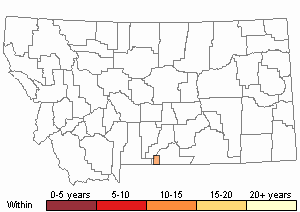
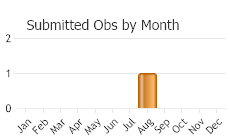
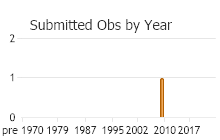
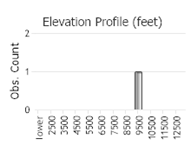 (Observations spanning multiple months or years are excluded from time charts)
(Observations spanning multiple months or years are excluded from time charts)
Migration
Non-migratory.
Habitat
Above treeline in dry alpine meadows and talus slopes, moist alpine and subalpine heath, subarctic moist willow thickets, clearings in black spruce bogs, forest clearings, montane aspen (Nabokov 1953; Oosting and Parshall 1978; Scott 1986; Threatful 1988; Layberry et al. 1998; Opler and Wright 1999; Glassberg 2001; Pyle 2002). Habitat in Montana not described but probably similar.
Food Habits
Larval food plants in the wild and captivity are members of the Rosaceae, including Fragaria, Potentillia, and Rubus, and members of the Ericaceae, specifically Vaccinium caespitosum (Scott 1986, 1992, 2006; Layberry et al. 1998; James and Nunnallee 2011). Adults feed on flower nectar (including Arnica, Barbarea, Erigeron, Fragaria, Hymenoxys, Kalmia, Mertensia, Polygonum, Salix, Sedum, Senecio, Symphyotrichum, Taraxacum, Trollius, Viola) and mud (James and Nunnallee 2011; Scott 2014).
Reproductive Characteristics
Females lay eggs singly on undersurface of host plant leaves (Scott 1986, 1992, 2006). A single captive female laid 57 eggs during nine days. Eggs hatch in about 9 days (depending on temperature), develop from L1 instar to L5 instar 40-48 days after after egg-hatch, L5 instar to pupae in about 27-28 days (depending on temperature). Larvae feed on host plant leaves, L1 instar constructs lightly-silked folded leaf nest, leave nest to feed at night, construct new nest when too large to occupy current nest, may be cannibalistic in captivity, slow L5 instar development indicates possible overwinting (diapause) as L4 or L5 instar, pupates in final leaf nest on host plant (James and Nunnallee 2011). Males patrol throughout the day, sometimes perch, in low spots, swales, valley bottoms, next to bogs, seeking females (Scott 1975b, 1986).
Stewardship Responsibility
References
- Literature Cited AboveLegend:
 View Online Publication
View Online Publication Bird, C.D., G.I. Hilchie, N.G. Kondla, E.M. Pike, and F.A.H. Sperling. 1995. Alberta Butterflies. The Provincial Museum of Alberta, Edmonton. 349 pp.
Bird, C.D., G.I. Hilchie, N.G. Kondla, E.M. Pike, and F.A.H. Sperling. 1995. Alberta Butterflies. The Provincial Museum of Alberta, Edmonton. 349 pp. Brown, F.M. 1957. Colorado Butterflies. Proceedings; Numbers Three through Seven. Denver Museum of Natural History, Denver, Co.
Brown, F.M. 1957. Colorado Butterflies. Proceedings; Numbers Three through Seven. Denver Museum of Natural History, Denver, Co. Ferris, C.D. and F.M. Brown (eds). 1981. Butterflies of the Rocky Mountains. Univ. of Oklahoma Press. Norman. 442 pp.
Ferris, C.D. and F.M. Brown (eds). 1981. Butterflies of the Rocky Mountains. Univ. of Oklahoma Press. Norman. 442 pp. Glassberg, J. 2001. Butterflies through Binoculars: A Field Guide to the Butterflies of Western North America. Oxford University Press.
Glassberg, J. 2001. Butterflies through Binoculars: A Field Guide to the Butterflies of Western North America. Oxford University Press. Guppy, C.S. and J.H. Shepard. 2001. Butterflies of British Columbia: including western Alberta, southern Yukon, the Alaska Panhandle, Washington, northern Oregon, northern Idaho, northwestern Montana. UBC Press (Vancouver, BC) and Royal British Columbia Museum (Victoria, BC). 414 pp.
Guppy, C.S. and J.H. Shepard. 2001. Butterflies of British Columbia: including western Alberta, southern Yukon, the Alaska Panhandle, Washington, northern Oregon, northern Idaho, northwestern Montana. UBC Press (Vancouver, BC) and Royal British Columbia Museum (Victoria, BC). 414 pp. James, D.G. and D. Nunnallee. 2011. Life histories of Cascadia butterflies. Corvallis, OR: Oregon State University Press. 447 p.
James, D.G. and D. Nunnallee. 2011. Life histories of Cascadia butterflies. Corvallis, OR: Oregon State University Press. 447 p. Kohler, S. 1980. Checklist of Montana Butterflies (Rhopalocera). Journal of the Lepidopterists' Society 34(1): 1-19.
Kohler, S. 1980. Checklist of Montana Butterflies (Rhopalocera). Journal of the Lepidopterists' Society 34(1): 1-19. Layberry, R.A., P.W. Hall, and J.D. LaFontaine. 1998. The Butterflies of Canada. University of Toronto Press. 280 pp. + color plates.
Layberry, R.A., P.W. Hall, and J.D. LaFontaine. 1998. The Butterflies of Canada. University of Toronto Press. 280 pp. + color plates. Nabokov, V. 1953. Butterfly collecting in Wyoming, 1952. The Lepidopterists' News 7(2): 49-52.
Nabokov, V. 1953. Butterfly collecting in Wyoming, 1952. The Lepidopterists' News 7(2): 49-52. Oosting, D.P. and D.K. Parshall. 1978. Ecological notes on the butterflies of the Churchill region of northern Manitoba. Journal of Research on the Lepidoptera 17(3): 188-203.
Oosting, D.P. and D.K. Parshall. 1978. Ecological notes on the butterflies of the Churchill region of northern Manitoba. Journal of Research on the Lepidoptera 17(3): 188-203. Opler, P.A. and A.B. Wright. 1999. A field guide to western butterflies. Second edition. Peterson Field Guides. Houghton Mifflin Company, Boston, Massachusetts. 540 pp.
Opler, P.A. and A.B. Wright. 1999. A field guide to western butterflies. Second edition. Peterson Field Guides. Houghton Mifflin Company, Boston, Massachusetts. 540 pp. Opler, P.A., K. Lotts, and T. Naberhaus, coordinators. 2010. Butterflies and moths of North America. Big Sky Institute, Bozeman, MT. Available at: www.butterfliesandmoths.org (Accessed 15 June 2015).
Opler, P.A., K. Lotts, and T. Naberhaus, coordinators. 2010. Butterflies and moths of North America. Big Sky Institute, Bozeman, MT. Available at: www.butterfliesandmoths.org (Accessed 15 June 2015). Pyle, R.M. 2002. The butterflies of Cascadia: a field guide to all the species of Washington, Oregon, and surrounding territories. Seattle Audubon Society, Seattle, Washington. 420 pp.
Pyle, R.M. 2002. The butterflies of Cascadia: a field guide to all the species of Washington, Oregon, and surrounding territories. Seattle Audubon Society, Seattle, Washington. 420 pp. Scott, J.A. 1975b. Mate-locating behavior of western North American butterflies. Journal of Research on the Lepidoptera 14:1-40.
Scott, J.A. 1975b. Mate-locating behavior of western North American butterflies. Journal of Research on the Lepidoptera 14:1-40. Scott, J.A. 1986. The butterflies of North America: a natural history and field guide. Stanford University Press, Stanford, California.
Scott, J.A. 1986. The butterflies of North America: a natural history and field guide. Stanford University Press, Stanford, California. Scott, J.A. 1992. Hostplant records for butterflies and skippers (mostly from Colorado) 1959-1992, with new life histories and notes on oviposition, immatures, and ecology. Papilio new series #6. 185 p.
Scott, J.A. 1992. Hostplant records for butterflies and skippers (mostly from Colorado) 1959-1992, with new life histories and notes on oviposition, immatures, and ecology. Papilio new series #6. 185 p. Scott, J.A. 2006. Butterfly hostplant records, 1992-2005, with a treatise on the evolution of Erynnis, and a note on new terminology for mate-locating behavior. Papilio new series #14. 74 p.
Scott, J.A. 2006. Butterfly hostplant records, 1992-2005, with a treatise on the evolution of Erynnis, and a note on new terminology for mate-locating behavior. Papilio new series #14. 74 p. Scott, J.A. 2014. Lepidoptera of North America 13. Flower visitation by Colorado butterflies (40,615 records) with a review of the literature on pollination of Colorado plants and butterfly attraction (Lepidoptera: Hersperioidea and Papilionoidea). Contributions of the C.P. Gillette Museum of Arthopod Diversity. Fort Collins, CO: Colorado State University. 190 p.
Scott, J.A. 2014. Lepidoptera of North America 13. Flower visitation by Colorado butterflies (40,615 records) with a review of the literature on pollination of Colorado plants and butterfly attraction (Lepidoptera: Hersperioidea and Papilionoidea). Contributions of the C.P. Gillette Museum of Arthopod Diversity. Fort Collins, CO: Colorado State University. 190 p. Scott, J.A. and G.R. Scott. 1978. Ecology and distribution of the butterflies of southern central Colorado. Journal of Research on the Lepidoptera 17(2): 73-128.
Scott, J.A. and G.R. Scott. 1978. Ecology and distribution of the butterflies of southern central Colorado. Journal of Research on the Lepidoptera 17(2): 73-128. Stanford, R.E. and P.A. Opler. 1993. Atlas of western USA butterflies: including adjacent parts of Canada and Mexico. Unpubl. Report. Denver and Fort Collins, Colorado 275 pp.
Stanford, R.E. and P.A. Opler. 1993. Atlas of western USA butterflies: including adjacent parts of Canada and Mexico. Unpubl. Report. Denver and Fort Collins, Colorado 275 pp. Threatful, D.L. 1988. A list of the butterflies and skippers of Mount Revelstoke and Glacier National Parks, British Columbia, Canada (Lepidoptera). Journal of Research on the Lepidoptera 27(3-4): 213-221.
Threatful, D.L. 1988. A list of the butterflies and skippers of Mount Revelstoke and Glacier National Parks, British Columbia, Canada (Lepidoptera). Journal of Research on the Lepidoptera 27(3-4): 213-221.
- Additional ReferencesLegend:
 View Online Publication
View Online Publication
Do you know of a citation we're missing? Allen, T.J., J.P. Brock, and J. Glassberg. 2005. Caterpillars in the field and garden: a field guide to the butterfly caterpillars of North America. Oxford University Press.
Allen, T.J., J.P. Brock, and J. Glassberg. 2005. Caterpillars in the field and garden: a field guide to the butterfly caterpillars of North America. Oxford University Press. Brock, J.P. and K. Kaufman. 2003. Kaufman Field Guide to Butterflies of North America. Houghton Mifflin Company, New York, NY 284 pp.
Brock, J.P. and K. Kaufman. 2003. Kaufman Field Guide to Butterflies of North America. Houghton Mifflin Company, New York, NY 284 pp. Forister, M.L., E.M. Grames, C.A. Halsch, K.J. Burls, C.F. Carroll, K.L. Bell, J.P. Jahner, et al. 2023. Assessing risk for butterflies in the context of climate change, demographic uncertainty, and heterogeneous data sources. Ecological Monographs 93(3):e1584. https://doi.org/10.1002/ecm.1584
Forister, M.L., E.M. Grames, C.A. Halsch, K.J. Burls, C.F. Carroll, K.L. Bell, J.P. Jahner, et al. 2023. Assessing risk for butterflies in the context of climate change, demographic uncertainty, and heterogeneous data sources. Ecological Monographs 93(3):e1584. https://doi.org/10.1002/ecm.1584
- Web Search Engines for Articles on "Grizzled Skipper"
- Additional Sources of Information Related to "Insects"





